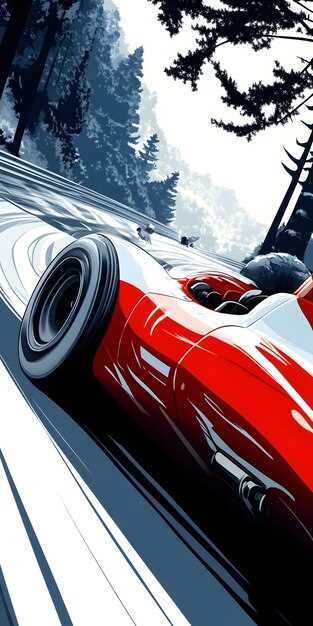
The concept of downforce plays a crucial role in the engineering of sports cars, primarily affecting their stability and performance at high speeds. As vehicles accelerate, various aerodynamic components work together to generate a force that pushes the car down onto the track, allowing for improved grip and cornering ability. Understanding the mechanics of downforce is essential for engineers who strive to enhance the performance characteristics of high-performance vehicles.
In sports car design, the generation of downforce is achieved through the strategic integration of wings, spoilers, and diffusers. Each of these components is carefully crafted to manipulate airflow around the car, creating a differential pressure that maximizes tire contact with the road surface. As a result, engineers must balance aerodynamic efficiency and the desired levels of downforce to reach optimum performance without compromising speed.
Furthermore, the relationship between downforce and drag can significantly influence a car’s overall efficiency. An effective sports car design will seek to maximize downforce while minimizing air resistance, enabling the vehicle to maintain high speeds without losing traction. This intricate balance highlights the necessity for continuous research and innovation within the realm of sports car engineering, as teams push the limits of technology to create the ultimate driving machines.
Understanding Aerodynamic Forces: Lift and Downforce in Sports Cars
Aerodynamics plays a crucial role in the performance and handling of sports cars, with two significant forces at play: lift and downforce. Lift is the upward force generated by airflow over a vehicle, which can impair stability at high speeds. In contrast, downforce is the downward force that pushes a car onto the track, enhancing grip and cornering ability.
Sports cars are designed to minimize lift while maximizing downforce. This is achieved through various aerodynamic components, such as spoilers, wings, and diffusers. These elements manipulate air pressure around the vehicle, creating a negative pressure zone that effectively pulls the car closer to the ground. By increasing downforce, engineers improve tire adhesion, allowing for higher cornering speeds and better overall control.
The balance between lift and downforce is critical. Excessive lift can result in loss of traction, while inadequate downforce can lead to instability, particularly during aggressive maneuvering. Therefore, designers carefully calculate shapes and angles to optimize airflow, ensuring that downforce is maximized without introducing unwanted aerodynamic drag.
Testing and validation of aerodynamic performance are often conducted using wind tunnels and computational fluid dynamics (CFD) simulations. These methods enable engineers to visualize airflow patterns and make adjustments to the vehicle’s design before final production. The integration of innovative materials and technologies continues to advance the effectiveness of downforce generation in sports car engineering.
In summary, a comprehensive understanding of aerodynamic forces, especially downforce, is essential in sports car engineering. This knowledge allows for the creation of high-performance vehicles that can achieve remarkable speeds and exceptional handling characteristics on the track.
Designing Spoilers and Diffusers for Optimal Downforce

In the realm of sports car engineering, achieving optimal downforce is crucial for enhancing performance and stability. Spoilers and diffusers are two primary aerodynamic features designed to manipulate airflow, thereby increasing downforce on the vehicle.
Spoilers are strategically placed on the rear of the car. Their primary function is to disrupt the turbulent air that forms behind the vehicle, thus reducing lift. The effective design of a spoiler involves careful consideration of its angle, shape, and height. A well-designed spoiler not only maximizes downforce but also minimizes drag, contributing to better overall performance. Factors such as the material used and the specific vehicle characteristics also play significant roles in achieving the desired aerodynamic effect.
Diffusers, on the other hand, are located under the rear of the car. Their purpose is to accelerate the air flowing underneath, creating a low-pressure zone. This zone pulls the vehicle down toward the road, increasing downforce. The design of a diffuser requires expertise to balance airflow smoothly and efficiently. It is essential to consider the angle of the diffuser, as well as its length and width, to optimize airflow and ensure maximum downforce without incurring excessive drag.
Combining the effects of both spoilers and diffusers can lead to a synergistic increase in downforce. Engineers often use computational fluid dynamics (CFD) simulations and wind tunnel testing to refine these components, ensuring they work harmoniously with other aerodynamic features of the car. By focusing on airflow patterns and pressure distributions, designers can significantly enhance the car’s grip and handling, especially at high speeds.
Ultimately, the careful design of spoilers and diffusers is essential for achieving optimal downforce. This not only improves cornering capabilities but also enhances safety and driver confidence on the track. The continual evolution of materials and technology further allows engineers to push the boundaries of aerodynamic efficiency, creating sports cars that excel in both performance and stability.
Measuring and Testing Downforce: Tools and Techniques for Engineers

Accurately measuring and testing downforce is crucial for sports car engineers aiming to optimize vehicle performance. Various tools and techniques exist to achieve reliable assessments of aerodynamic forces acting on a car during operation.
One commonly used method is the use of a wind tunnel. This controlled environment allows engineers to simulate real-world driving conditions, enabling precise measurements of downforce across different speeds and angles. Models of the car are tested, providing invaluable data on airflow patterns and pressure distribution.
Another effective technique involves CFD (Computational Fluid Dynamics) simulations. CFD tools generate digital models that predict how air flows around a vehicle. Engineers can manipulate various design elements in the software to analyze their impact on downforce, reducing the need for extensive physical testing.
Additionally, strain gauge testing offers a direct approach to measuring downforce in real-time during vehicle testing. Strain gauges are mounted on critical structural components, capturing the force exerted by downforce under dynamic conditions. This data helps in understanding how aerodynamic loads affect the vehicle’s performance and stability.
Furthermore, load cells can be used to quantify the total aerodynamic load on an entire vehicle. These devices measure forces acting on the car as it interacts with the road, providing comprehensive insights into the downforce produced during various maneuvers.
Finally, data collection and analysis tools, such as data loggers and telemetry systems, play a vital role in capturing real-time downforce data during track tests. These systems allow engineers to assess how changes in design and aerodynamics influence vehicle behavior at high speeds.
By utilizing these advanced tools and techniques, engineers can methodically measure and test downforce, leading to enhanced vehicle designs that maximize performance and safety on the track.



